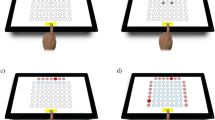Abstract
The article deals with measurements of ability to maintain the balance conducted for soldiers who were wounded during combat missions. Measurements were carried out both in real and virtual environment. Tests in the real environments were performed with open and closed eyes. Tests in the virtual environment were performed with the use of spatial sceneries which were immobile or were oscillating in AP direction. Analysis of results was conducted both in time domain and frequency domain. All results were compared with the literature results obtained for healthy people. Results obtained for soldiers differed from the results of healthy people. According to the obtained results, it can be concluded that the studies of the ability to maintain the balance should be carried out both in static and dynamic conditions, and the analysis of the obtained results should be carried out both in time and frequency domain.
Access this chapter
Tax calculation will be finalised at checkout
Purchases are for personal use only
Similar content being viewed by others
References
Jennings, B.M., Yoder, L.H., Heiner, S.L., Loan, L.A., Bingham, M.O.: Soldiers with musculoskeletal injuries. J. Nursing Schol. 40(3), 268–274 (2008)
Jin-Hyuck, L., Jae-Won, H., Dae-Hee, L.: Comparative postural stability in patients with lateral meniscus versus medial meniscus tears. Knee 25(2), 256–261 (2018)
Jurkojć, J., Wodarski, P., Bieniek, A., Gzik, M., Michnik, R.: Influence of changing frequency and various sceneries on stabilometric parameters and on the effect of adaptation in an immersive 3D virtual environment. Acta Bioeng. Biomech. 19(3), 129–137 (2017)
Jurkojć, J.: Badania zdolności utrzymywania równowagi ciała przez człowieka w środowisku rzeczywistym i wirtualnym. Wydawnictwo Politechniki śląskiej, Gliwice (2018)
Jurkojć, J.: Balance disturbances coefficient as a new value to assess ability to maintain balance on the basis of FFT curves. Acta Bioeng. Biomech. 20(1), 143–151 (2018)
Keshner, E.A., Kenyon, R.V.: The influence of an immersive virtual environment on the segmental organization of postural stabilizing responses. J. Vestibul. Res. 10, 207–219 (2000)
Kocjan, J., Gzik-Zroska, B., Nowakowska, K., Burkacki, M., Suchon, S., Michnik, R., Czyzewski, D., Adamek, M.: Impact of diaphragm function parameters on balance maintenance. Plos One 13(12) (2018)
Korzeniewski, K., Bochniak, A.: Medical support of military operations in Iraq and Afghanistan. Int. Maritime Health 63(1), 71–76 (2011)
Lee, D.N., Aronson, E.: Visual proprioceptive control of standing in human infants. Percept. Psychophys. 15(3), 529–532 (1974)
Mehlhorn, A.T., Walther, M., Yilmazm, T., Gunst, L., Hirschmüller, A., Südkamp, N.P., Schmal, H.: Dynamic plantar pressure distribution, strength capacity and postural control after Lisfranc fracture-dislocation. Gait Post. 52, 332–337 (2017)
Michnik, R., Jurkojć, J., Wodarski, P., Gzik, M., Jochymczyk-Woźniak, K., Bieniek, A.: The influence of frequency of visual disorders on stabilographic parameters. Acta Bioeng. Biomech. 18(1), 25–33 (2016)
Monaghan, K., Delahunt, E., Caulfield, B.: Ankle function during gait in patients with chronic ankle instability compared to controls. Clin. Biomech. 21(2), 168–174 (2006)
Pau, M., Porta, M., Arippa, F., Pillonia, G., Sorrentino, M., Carta, M., Mura, M., Leban, B.: Dynamic postural stability, is associated with competitive level, in youth league soccer players. Phys. Therapy Sport 35, 36–41 (2019)
Pauk, J., Ihnatouski, M., Najafi, B.: Assessing plantar pressure distribution in children with flatfoot arch application of the clarke angle. J. Am. Podiat. Med. Assoc. 104(6), 622–632 (2014)
Sell, T.C.: An examination, correlation, and comparison of static and dynamic measures of postural stability in healthy, physically active adults. Phys. Therapy Sport 13, 80–86 (2012)
Simpson, J.D., Stewart, E.M., Macias, D.M., Chandera, H., Knight, A.C.: Individuals with chronic ankle instability exhibit dynamic postural stability deficits and altered unilateral landing biomechanics: A systematic review. Phys. Therapy Sport 37, 210–219 (2019)
Sinitski, E.H., Thompson, A.A., Godsell, P., Honey, J., Besemann, M.: Postural stability and simulator sickness after walking on a treadmill in a virtual environment with a curved display. Displays 52, 1–7 (2018)
Tossavainen, T., Juhola, M., Pyykko, I., Aalto, H., Toppila, E.: Development of virtual reality stimuli for force platform posturography. Int. J. Med. Inf. 70, 277–283 (2003)
Wiszomirska, I., Bende, N., Patej, M., Blazkiewicz, M.: The impact of sensorimotor training on postural stability and motor skills of basketball players in the prevention of injuries. Med. Dello Sport 70(3), 354–364 (2017)
Acknowledgements
The research was done within the project no. DOBR-BIO4/022/131449/2013 ’Improving the Safety and Protection of Soldiers on Missions Through Research and Development in Military Medical and Technical Areas’ supported and cofinanced by NCR& D.
Author information
Authors and Affiliations
Corresponding author
Editor information
Editors and Affiliations
Rights and permissions
Copyright information
© 2021 The Editor(s) (if applicable) and The Author(s), under exclusive license to Springer Nature Switzerland AG
About this paper
Cite this paper
Wodarski, P., Jurkojć, J., Chmura, M., Bieniek, A., Guzik-Kopyto, A., Michnik, R. (2021). Analysis of the Ability to Maintain the Balance of Veterans of Stabilization Missions. In: Gzik, M., Paszenda, Z., Pietka, E., Tkacz, E., Milewski, K. (eds) Innovations in Biomedical Engineering. AAB 2020. Advances in Intelligent Systems and Computing, vol 1223. Springer, Cham. https://doi.org/10.1007/978-3-030-52180-6_22
Download citation
DOI: https://doi.org/10.1007/978-3-030-52180-6_22
Published:
Publisher Name: Springer, Cham
Print ISBN: 978-3-030-52179-0
Online ISBN: 978-3-030-52180-6
eBook Packages: Intelligent Technologies and RoboticsIntelligent Technologies and Robotics (R0)




